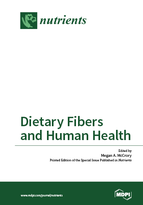Dietary Fibers and Human Health
A special issue of Nutrients (ISSN 2072-6643).
Deadline for manuscript submissions: closed (15 December 2016) | Viewed by 272218
Special Issue Editor
Interests: eating patterns; meal timing; dietary composition; taste preferences; sleep patterns; physical activity; appetite; obesity; energy regulation; chronic disease risk; psychological factors; dietary assessment methodology; wearable technology
Special Issues, Collections and Topics in MDPI journals
Special Issue Information
Dietary fiber has long been recognized for its role in digestive function. However, currently there is scientific debate about definitions (descriptive and analytical), optimal intake, and essentiality in the human diet. Dietary fiber is a key substrate for bacterial metabolism in the colon, which makes research on dietary fiber an important issue that complements current interest in the gut microbiota. Dietary fiber is also important for prevention and management of cardiovascular disease, diabetes, obesity, and other chronic diseases. This Special Issue will highlight recent research on dietary fiber content in foods and function in human health, ranging from digestive function to chronic disease prevention and management.
Clinical Assoc. Prof. Dr. Megan A. McCrory
Guest Editor
Manuscript Submission Information
Manuscripts should be submitted online at www.mdpi.com by registering and logging in to this website. Once you are registered, click here to go to the submission form. Manuscripts can be submitted until the deadline. All submissions that pass pre-check are peer-reviewed. Accepted papers will be published continuously in the journal (as soon as accepted) and will be listed together on the special issue website. Research articles, review articles as well as short communications are invited. For planned papers, a title and short abstract (about 100 words) can be sent to the Editorial Office for announcement on this website.
Submitted manuscripts should not have been published previously, nor be under consideration for publication elsewhere (except conference proceedings papers). All manuscripts are thoroughly refereed through a single-blind peer-review process. A guide for authors and other relevant information for submission of manuscripts is available on the Instructions for Authors page. Nutrients is an international peer-reviewed open access semimonthly journal published by MDPI.
Please visit the Instructions for Authors page before submitting a manuscript. The Article Processing Charge (APC) for publication in this open access journal is 2900 CHF (Swiss Francs). Submitted papers should be well formatted and use good English. Authors may use MDPI's English editing service prior to publication or during author revisions.
Keywords
- Dietary fiber
- Fermentation
- Viscosity
- Solubility
- Definition
- Prebiotic
- Appetite
- Glucose control







